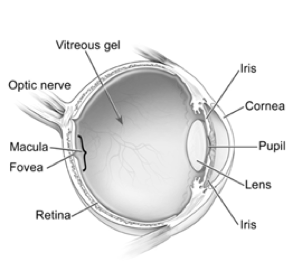June 2019 Newsletter
Sharp Vision, Sharp Mind
Cataracts are the leading cause of reversible blindness in people 55 and older, but did you know they could also contribute to an increased risk for cognitive decline and dementia?
What is a Cataract?
A cataract is a clouding of the lens in the eye that affects vision. Most cataracts are related to aging but can occur due to medications, medical illness, heredity, or sun exposure. Cataracts are very common in older people. By age 80, more than half of all Americans either have a cataract or have had cataract surgery.
A cataract can occur in either or both eyes. It cannot spread from one eye to the other.
What is the Lens?
The lens is a clear part of the eye that helps to focus light on the retina. The retina is the light-sensitive tissue at the back of the eye.
In a normal eye, light passes through the transparent lens to the retina. Once it reaches the retina, light is changed into nerve signals that are sent to the brain to form an image that we perceive as vision.
Normal Vision
What Causes Cataracts?
The lens lies behind the iris and the pupil. It works much like a camera lens. It focuses light onto the retina at the back of the eye, where an image is recorded.
The same scene as viewed by a person with cataracts
The lens also adjusts the eye's focus, letting us see things clearly both up close and far away. The lens is made of mostly water and protein. The protein is arranged in a precise way that keeps the lens clear and lets light pass through it.
As we age, some of the protein may clump together and start to cloud a small area of the lens. This is a cataract. Over time, the cataract may grow larger and cloud more of the lens, making it harder to see.
Cataract Surgery
Cataract surgery is performed as a short outpatient procedure, either in a hospital or ambulatory surgery center. The patient receives medications in the form of eye drops to dilate the pupil to allow for access to the clouded lens to be removed.
Patients are traditionally given topical anesthesia to numb the eye, along with an intravenous medication for sedation. Once the eye is numb, two tiny incisions are created in the ocular surface to allow instruments to be placed inside of the eye. The shell holding the lens is opened, the cataract broken in small pieces inside the eye, then vacuumed out to leave an empty shell in which a clear artificial lens implant can then be placed. The patient receives both intraocular and topical antibiotics and anti-inflammatory medications to facilitate healing.
Postoperative follow up consists of short office visits to check vision, eye pressure, and short clinical examination, along with instructions on how to modify postoperative eye drops to optimize vision. Every patient is different, and only your eye care professional will be able to help you decide if cataract surgery is right for you.
Below is a short educational video.
June is Cataract Awareness Month
In This Issue
Sharp Vision, Sharp Mind
What is a Cataract?What is the Lens?
What Causes Cataracts?
Cataract Surgery
Contact Us
2311 W. Hayes Ave,
Fremont
Ohio 43420
(419) 334 8121
622 Parkway Drive,
Fostoria
Ohio 44830
(419) 435 3482
Thursday, June 27th is National Sunglasses Day
In celebration of this, at the Eye Centers of Northwest Ohio we are giving 50% off all of our sunglass frames for the whole month of June 2019 (not be combined with insurance or other discounts?)
Courtesy: National Eye Institute, National Institutes of Health (NEI/NIH)
No Vision Insurance, No Problem. Join our Membership Program today!
Stop In Before You Head Out
Our offices can help you have your day in the sun and do it safely. We offer quality sunglasses – both prescription and non-prescription – that meet the highest standards for sun protection. We offer them in styles to suit everyone, from infants through adults. Call us for an appointment today.








